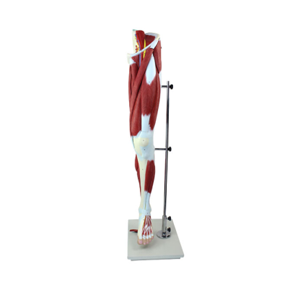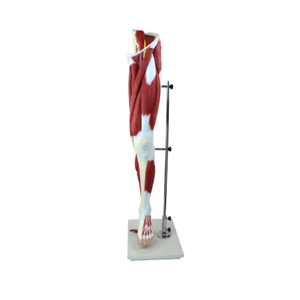ADA MED SUPPLY LIMITED
Phone:+86 19937901373
Tel:+86-0379-65160607
Email:adaanatomy@adaanatomy.com

Article tag: Lower limb muscle anatomy model muscle anatomy model

The anatomical model of lower limb muscle plays a vital role in the field of physical training, which not only provides an intuitive display of muscle structure, but also profoundly affects the reshaping of physical training mode and promotes the overall improvement of training methods and effects.
Firstly, through its precise muscle distribution and connection relationships, it helps trainers and athletes gain a deep understanding of the functional characteristics and movement mechanisms of muscles. This in-depth understanding enables training plans to be formulated more scientifically and systematically, with targeted training for different muscle groups, thereby improving training efficiency and effectiveness.

Secondly, the application of the model promotes the development of personalized training. Each person's muscle shape and strength distribution are different, and the traditional "one-size-fits-all" training model is often difficult to meet the needs of different individuals. The lower limb muscle anatomy model can be customized according to the individual's specific situation, to ensure that the training content matches the individual characteristics, and to maximize the training effect.
In addition, the model also promotes the innovation of multi-dimensional and multi-level training methods. Through the model, the trainer can design more complex and changeable training movements, which not only covers the strength training of muscles, but also integrates various training elements such as flexibility, coordination, and stability. This comprehensive training method contributes to the overall improvement of athletes' physical fitness and athletic performance.
In physical training, the strength and endurance of the lower limb muscles are crucial. The application of the model enables the trainer to accurately evaluate the strength level of the athletes' lower extremity muscle and make targeted training plans according to the evaluation results. Through systematic training, the athletes' lower limb muscle strength has been significantly improved, laying a solid foundation for their excellent performance in various sports.
In summary, the lower limb muscle anatomy model reshapes the physical training model by providing accurate muscle structure display, promoting personalized training and multi-dimensional training method innovation. It not only improves the scientific and targeted training, but also promotes the overall improvement of the training effect, and provides a strong guarantee for the athletes to achieve excellent results in the arena.